New free trade agreement to add $16bn to Vietnam’s exports to EU: expert
New free trade agreement to add $16bn to Vietnam’s exports to EU: expert
With commitments to openness and intellectual property protection, the EU-Vietnam Free Trade Agreement (EVFTA) is expected by economic experts to increase Vietnam’s exports to the European Union by US$16 billion in 2019.

The European Commission (EC) adopted the EU-Vietnam trade and investment agreements on Wednesday, paving the way for their signature and conclusion, according to the EU’s delegation to Vietnam.
Through this adoption, the Commission is demonstrating its commitment to putting these agreements in place as soon as possible, the EC said in its press release.
The Commission is now submitting to the Council the proposals for the signature and conclusion of both agreements.
Once authorised by the Council, the agreements will be signed and presented to the European Parliament for consent.
When the European Parliament has given its consent, the trade agreement can then be concluded by the Council and enter into force.
In the meantime, the investment protection agreement with Vietnam will be ratified by the EU member states according to their respective internal procedures.
Thanks to the trade agreement, it is calculated that the total growth rate of Vietnam’s exports to the EU will rise around four to six percent, equal to $16 billion in 2019 and $75 billion by 2028, according to economic expert Nguyen Le Dinh Quy.
The EVFTA will eliminate over 99 percent of all tariffs, and partly remove the rest through limited zero-duty quotas, known as Tariff Rate Quotas (TRQs).
Vietnam will erase 65 percent of import duties on EU exports from entry into force of the agreement, with the remainder of duties being gradually eliminated over a ten-year period.
In return, EU duties on imports from Vietnam will be eliminated progressively over a seven-year period.
Currently, only 42 percent of Vietnam’s exports to EU enjoy the zero-duty quotas under the Commission’s Generalized Scheme of Preferences (GSP).
Under the new trade agreement, experts anticipated that a range of Vietnam’s key export products to the EU, including agro-forestry-aquatic products, textiles, footwear, machinery and appliances, and automobiles, will benefit from tariff removals.
“Specifically, Vietnamese tuna will have an absolute advantage as the same product from its two main competitors, Thailand and China, may lose attractiveness in terms of price as none of the two countries have signed a free trade agreement with the EU,” Quy said in an analysis sent to Tuoi Tre (Youth) newspaper.
The same thing is also expected for Vietnam’s shrimp, which currently account for 14 percent of the world’s market share, second only to 15 percent of India.
In the context of the suspension of the free trade discussion between the EU and India, the EVFTA is considered a chance for Vietnamese shrimp to beat the Indian counterparts for the first place.
Currently, tuna and shrimp imports from Vietnam into the EU are subject to the duty ranges of 11-20 percent and 6-20 percent, respectively.
In addition, the EVFTA also regulates that EU companies will be able to bid for public contracts with Vietnamese ministries and important state-owned enterprises, as well as the two biggest Vietnamese cities, Hanoi and Ho Chi Minh City.
The agreement is fully in line with the rules of the WTO Government Procurement Agreement, thus achieving a degree of transparency and procedural fairness comparable to other EU trade agreements with developed countries and more advanced developing countries, the EC stated.




















